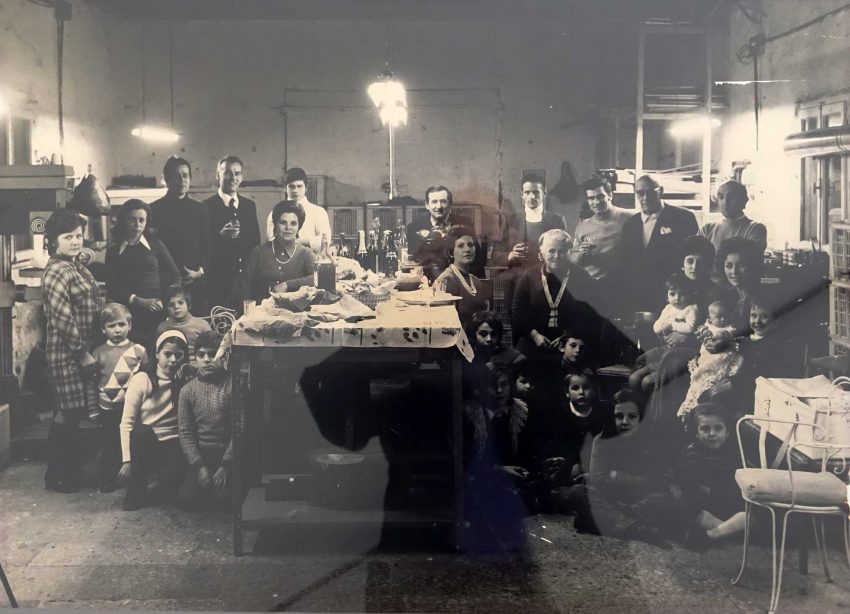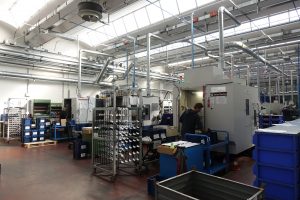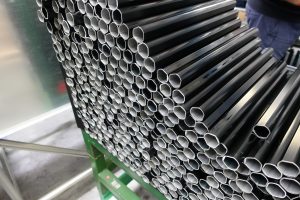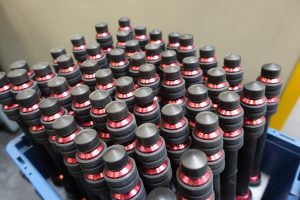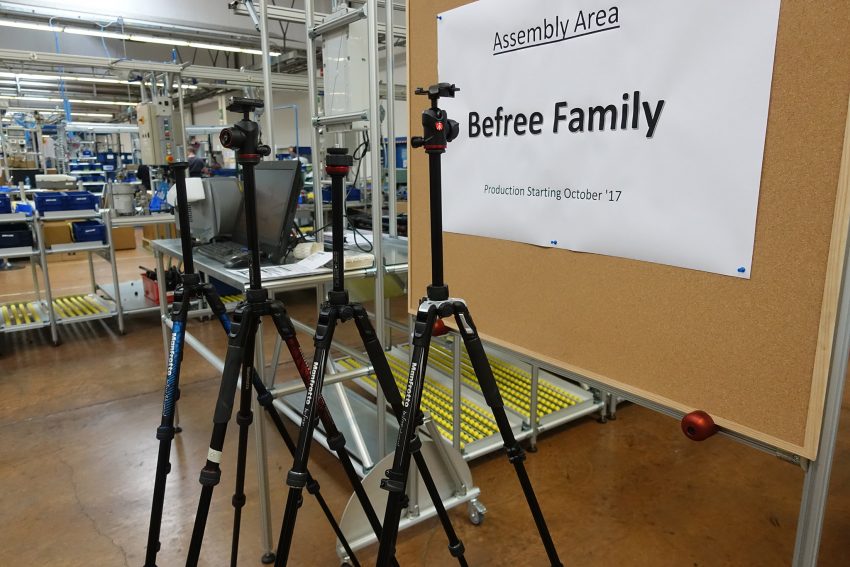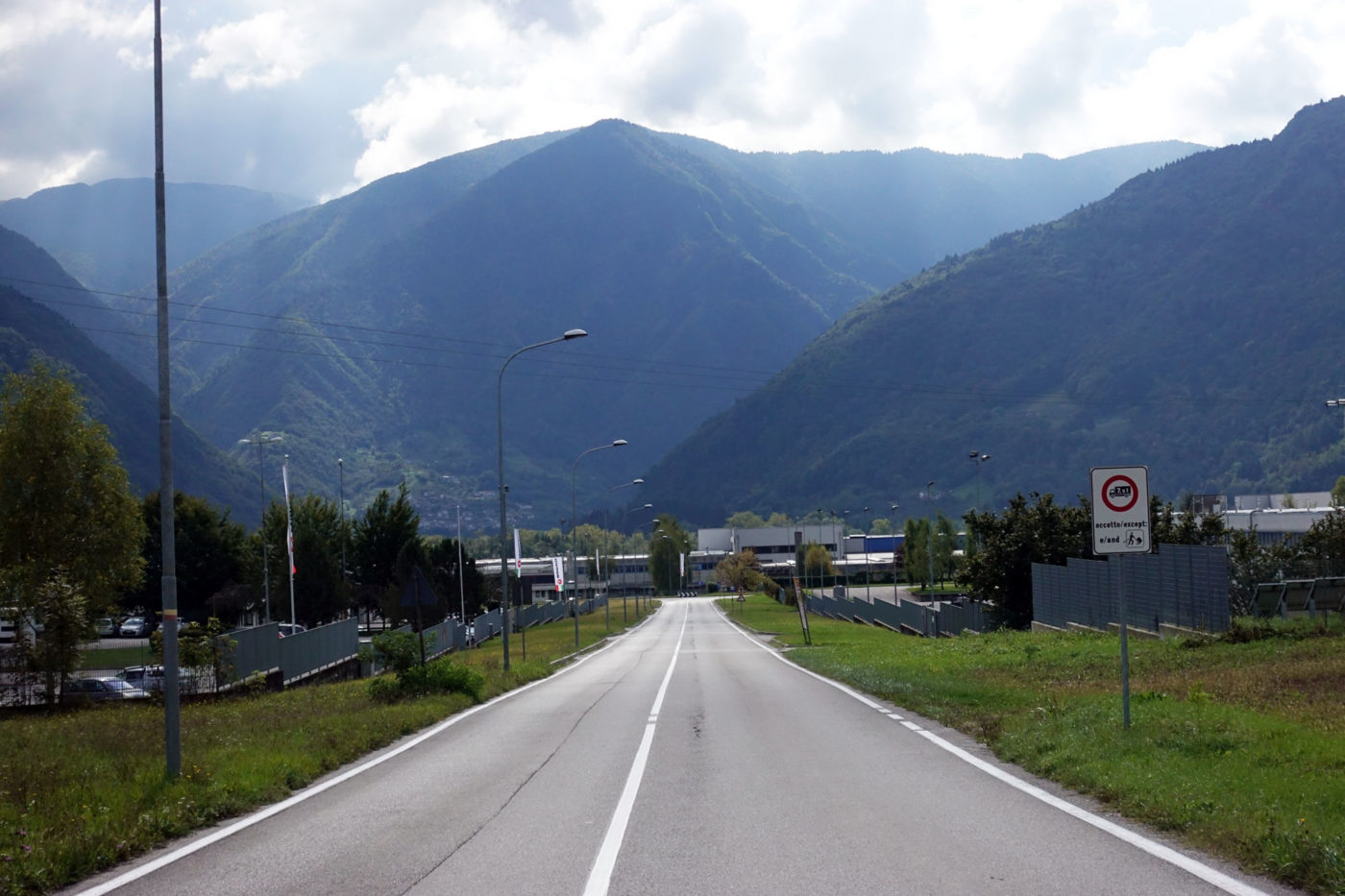
Lino Manfrotto was a photo journalist, based in Bassano del Grappa, Italy. He worked for Il Gazzettino and Il Giornale di Vicenza and also did industrial and advertising photography. By the late 1960s, he realized that his photo equipment was cumbersome, heavy and slow. There were many studio lights on the market, but Lino saw that they neglected the basic necessities. So, with the help of a colleague, Lino made his first product: a lightweight and a rugged lighting stand that extended high enough to be practical. Working out of the garage of his house, he built a few units for his photographer friends. Later, he decided to distribute them internationally. His first big order came from a Swiss distributor. The need to expand soon became clear.
- The Manfrotto family in the 1960s. Lino Manfrotto is at top left, wearing a black pullover.
- Lino Manfrotto (at right) and Gilberto Battochio in 1976.
In 1972, Lino Manfrotto met Gilberto Battocchio, who was working at a Bassano mechanical company. It was a pivotal moment. Gilberto, with his technical skills, was able to turn Lino’s ideas and designs into reality. The two made a great team. Within a few years, they built the company into a leading global business. In 1974, the first Manfrotto tripod was launched. Innovative, light and versatile, Manfrotto tripods and stands became very successful. Shortly after, Superboom, Autopole and Superclamp became important parts of every photo studio’s vocabulary.
By 1986, Manfrotto had 6 facilities in Bassano del Grappa. They added factories in Feltre, 43 km to the north. Here, in the industrial zone of Villapaiera, they built 5 more manufacturing plants in the next 2 years. By now, Manfrotto was distributed in 140 countries.
The Avenger brand was established in 1987 to build grip equipment for the professional studio and cine markets. In 1989, Manfrotto was sold to the Vitec Group. Lino and Gilberto joined the Vitec Group’s management. They acquired the French tripod and head manufacturer Gitzo in 1992 and Bogen, the American photo distribution company, in 1993.
With the changes that digital technology brought to photography and video, Manfrotto was in the right places at the right time to supply millions of new enthusiasts. By 2010, the last vestiges of the Bogen Imaging name had now become Manfrotto Distribution worldwide.
Today, from the corporate headquarters in Bassano del Grappa, 80 km northwest of Venice, Manfrotto designs, manufactures and markets a wide range of camera and lighting support equipment for the enthusiast and professional photography, cinema, theater, live entertainment and video markets. The product line includes an extensive range of camera tripods, heads, lights, stands, photo bags, pouches, backpacks and accessories.
Lino Manfrotto passed away in February 2017 at the age of 80. The company continues to grow. Manfrotto has manufacturing plants in Italy and 9 branches around the world, 735 employees, double digit annual growth, a 95% export rate, a 7% share in the global camera bag market, and more than 33% of the global tripod market. Let’s go on a tour of the Manfrotto company. For more information: www.manfrotto.com
Download our 11-page 6.4 MB PDF Report of the Factory Visit to Manfrotto in Italy.
Manfrotto
- Manfrotto corporate headquarters in Bassano del Grappa.
- Fabio Ganassin with new Befree tripods.
- Showroom at Manfrotto Headquarters.
- Markus Mahla, Chief Commercial Officer.
- The Social Media & Communication Team: Lorenza Bernardi, Claudia Rossi and Ulyana Khoma.
Every minute, more than 300 hours of video are uploaded to YouTube and other platforms. Manfrotto’s Befree tripods and heads address that enormous market of advanced amateurs. Befree Live has a fluid video head and is conceived for Content Creators. The Befree Advanced is a high performance travel tripod for Sony a7, a9 series cameras, Canon 5D Mk IV, Sony D850, etc. Its spider is more stable, and the new M-lock system makes for faster and more secure setup.
Nitrotech fluid heads are intended for cine cameras and heavier payloads. They employ a nitrogen-filled cylinder for continuous counterbalance control. The N8 handles up to 8 kg, has a 3/8-16 thread, has a 75mm ball base and pairs nicely with Manfrotto’s 546 or carbon fiber 535 legs. Nitrotch N12 fluid head is meant for cameras from 4 to 12 kg. It has a 100mm ball that levels nicely on a Manfrotto 536 carbon fiber tripod.
Manfrotto Manufacturing in Feltre
- Casting, milling and finishing aluminum and magnesium: 16 million pieces per year, 1,300 different part numbers. Above: before.
- The process involves deburring, shaving, sandblasting, lathe and CNC machining, and painting. 90% of the work is automated. Above: after.
- Casting and milling in F6 Factory.
- Aerial view of Feltre facilities.
- Robotic machining.
About 400 skilled employees work in the 7 factories at Manfrotto’s Feltre Industrial Park. Enrico Grando, Manufacturing Director of the Imaging Group, presented the layout.
F1 is where Gitzo Tripods and Heads are assembled. F2 is mold making and administration. F3 is maintenance, cafeteria and serice. F4 is for prototyping and product testing. F5 is the place for tube machining and gluing. F6 is a lean manufacturing assembly facility for magnesium and aluminum parts. F7 is where Manfrotto tripods and lighting supports are built.
There are several ways to build tripods. The ones with metal legs are cut and shaped from aluminum extruded rods. Carbon fiber tripods are made with sophisticated automated machines inhouse. The top sections, from which the legs are supported and onto which the camera is attached, are usually crafted from cast or milled aluminum or magnesium. The aluminum is heated to 760°C, magnesium a little lower. It takes 30 seconds to 1 minute.
I asked how an artisanal company like Manfrotto, with only 400 employees building high quality products, could compete in the world arena. Paolo Pozzi, Marketing and Communication Director, explained that Feltre can indeed prevail in the face of Asian competition. This area of northern Italy has been a high-tech manufacturing center for years. The team at Manfrotto is highly skilled. Many have been with the company for a long time. The factories are highly automated. Quality control is stringent. And the process is lean. Lean manufacturing is a method of improving the “flow” or smoothness of the work, eliminating waste, and having the parts for assembly readily at hand. Some production lines work in 3 shifts, 24 hours a day, 5 or 6 days a week.
Automation is a significant advantage to Manfrotto’s prowess. Giant machines shape many of the aluminum and carbon fiber tubes. Robots assemble and paint many of the sub-assemblies.
Manfrotto Casting and Finishing
Manfrotto Painting
- There are more than 300 colors as well as powder coating.
Manfrotto F1: Tripods and Heads
- GT5543LS Gitzo carbon fiber tripods.
F1 is the original plant in Feltre where Lino Manfrotto had assembled heads.
60 technicians work in 1 or 2 shifts. The manufacturing here is lean as well. The workstations are set up in U-shapes areas. At each station, the same amount of time is alotted to each person to perform a task. Every hour, they change positions. The workstations are ergonomic. Logistics are streamlined. Parts are distributed as required. About 1,000 tripods are built each day.
A new machine was installed a few weeks ago. With it, one new carbon fiber tube can be shaped every 4 seconds.
Everyone meets once a week to discuss and make suggestions. Ideas, performance and safety are rewarded.
Oh, and the “G” in Gitzo is pronounced like a “j” or like “Gee whiz.”
Manfrotto F5 Tube machining
- Manfrotto F5. Tube machining: cutting, trimming, punching, lathe machining, buckling, cleaning, welding, gluing of aluminum, carbon fiber and steel. 1,500 different parts, total of more than 6.8 million pieces a year.
- Massive new carbon fiber tube machine.
- Enrico Grando, Manufacturing Director, Imaging.
- Enrico Grando and Paolo Pozzi.
Manfrotto F7: Befree
- Manfrotto Befree Assembly Area went online October 2017.
- Paolo Pozzi and a Befree tripod.
Manfrotto and Avenger Lighting and Grip Support
Manfrotto Design and Prototyping
Bassano del Grappa
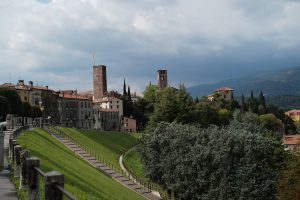
Manfrotto headquarters are in Bassano del Grappa (above), a city in the Veneto of 43,000 founded by the Romans around 200 BC. By 1404, it was part of the Republic of Venice. Ernest Hemingway was here. The 15th Century Villa Ca’ Erizzo Luca housed the American Red Cross during World War I and is the Hemingway Museum today. A Farewell to Arms was inspired by his time as an ambulance driver in the area.
- Birreria Ottone was founded in 1870 and still run by the same family.
Asolo and area
- In nearby Asolo, life is a movie. Giovanni Casellato created this homage to cinema in the town square of Asolo in June 2017.
- Andrea Sbrissa, Managing Director of Tenuta Baron, producer of Prosecco DOCG and fine wines—a few miles from Asolo and Bassano del Grappa.
- Osteria alla Chiesa in nearby Monfumo.
- Trattoria Due Mori, splendid food with a view over the hills of Asolo. Venice is 80 km the distant haze.

